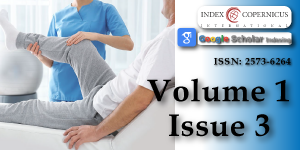Comparison of Lung Function of normal and persons with chronic low back pain and its relation with duration and severity of Chronic Low Back Pain
Main Article Content
Abstract
Introduction: Chronic low back pain is one of the most prevalent musculoskeletal disorders. Studies have shown certain relations between physical fitness and chronic low back pain (CLBP) by examine some measures of physical fitness. The aim of study was to measure lung function using winspiro PRO in patient with CLBP versus normal healthy individual, and relation of lung function with duration and intensity of CLBP.
Methodology: The study population is comprised of a total of 120 adult persons. 60 subjects with chronic low back pain (41 male and 19 female) with a mean age of 30.69 years (+4.34) and 60 normal individual (39 male and 21 female) with mean age of 29.00 years (+5.34).
Results:The result of comparison of the respiratory parameter forced vital capacity (FVC), and maximal voluntary ventilation (MVV) of individual with CLBP show a significant difference as compare to the normal healthy population. In unrelated ‘t’ test the patient with CLBP (N=60) of age 30.51(SD±4.33), height 169cm (SD±1.23), weight 57.86(SD±7.73) and body mass index (BMI) 20.46 (SD±2.54) show a significant difference in respiratory parameter FVC ( t=17.244, P=0.000), and MVV ( t=11.048, P=0.000) as compare to the normal healthy persons (N=60) of age 29.79 (SD±5.28), height 170cm (SD±1.13), weight 59.40(SD±6.97) and BMI 21.59 (SD±3.29).In patient group- FVC range is 34.0% to 75.00% (52.85%±9.30). MVV range is 45.0% to 86.80%. (63.11%±12.06)In control group FVC range is 63.90% to 98.83% (83.63%±7.59). MVV range is 63.00% to 98.00% (78.96%±7.86).
Conclusions:The overall result of the study show that there is a significant difference in the respiratory parameter that is FVC (forced vital capacity), and the MVV (maximum voluntary ventilation) in persons with chronic low back pain as compare to the healthy person of same age, height, weight and body mass index (BMI).
Article Details
Copyright (c) 2017 Baruaa A, et al.

This work is licensed under a Creative Commons Attribution 4.0 International License.
Krismer M, van Tulder M. Low Back Pain Group of the Bone and Joint Health Strategies for Europe Project (2007) Strategies for prevention and management of musculoskeletal conditions. Low back pain (non-specific). Best Pract Res Clin Rheumatol. 2007; 21: 77-91.
Hodges PW, Gandevia SC. Activation of the human diaphragm during a repetitive postural task. J Physiol. 2000; 522: 165-175. Ref.: https://goo.gl/ihZZm7
Courtney R. The functions of breathing and its dysfunctions and their relationship to breathing therapy. International Journal Osteopathic Medicine. 2009; 12: 78-85. Ref.: https://goo.gl/BGiQWS
McGill SM, Grenier S, Bluhm M, Richard P, Susan B, et al. Previous history of LBP with work loss is related to lingering effects in biomechanical physiological, personal, and psychosocial characteristics. Ergonomics. 2003; 46: 731-746. Ref.: https://goo.gl/ZmfCeV
Sapsford RR, Richardson CA, Maher CF, Hodges PW. Pelvic floor muscle activity in different sitting postures in continent and incontinent women. Arch Phys Med Rehabil. 2008; 89: 1741-1747. Ref.: https://goo.gl/1Tv7Vn
Murrin KR, Rosen M. Pain measurement. In: Smith G and Govindo BG (editors) Acute pain: London: Butterworth. 1985.
Kremer E, Atkinson JH, Ignelzi RJ. Measurement of pain: patient preference does not confound pain measurement. Pain. 1981; 10: 241-248. Ref.: https://goo.gl/gUdj6k
Revill SI, Robinson JO, Rosen M, Hogg MI. The reliability of a linear analogue for evaluating pain. Anaesthesia. 1976; 31: 1191-1198. Ref.: https://goo.gl/mcBhvN
Vianin M. Psychometric properties and clinical usefulness of the Oswestry Disability Index. J Chiropr Med. 2008; 7: 161-163. Ref.: https://goo.gl/wUa5cZ
Hussain SN, Rabinovitch B, Macklem PT, Pardy RL. Effects of separate rib cage and abdominal restriction on exercise performance in normal humans. J Appl Physiol. 1985; 58: 2020-2026. Ref.: https://goo.gl/spW8KB
Gonzalez J, Coast RJ, Lawler JM, Welch HG. A Chest Wall Restrictor to Study Effects on pulmonary Function and Exercise: 2. The Energetics of Restrictive Breathing. Respiration. 1999; 66: 188-194. Ref.: https://goo.gl/QgFrPb
Frank C, Kobesova A, Kolar P. Dynamic neuromuscular stabilization & sports rehabilitation. Int J Sports Phys Ther. 2013; 8: 62-73. Ref.: https://goo.gl/5wkKSJ
Neder JA, Andreoni S, Lerario MC, Nery LE. Reference values for lung function tests. II. Maximal respiratory pressures and voluntary ventilation. Braz J Med Biol Res. 1999; 32: 719-727. Ref.: https://goo.gl/Hq9PJe





